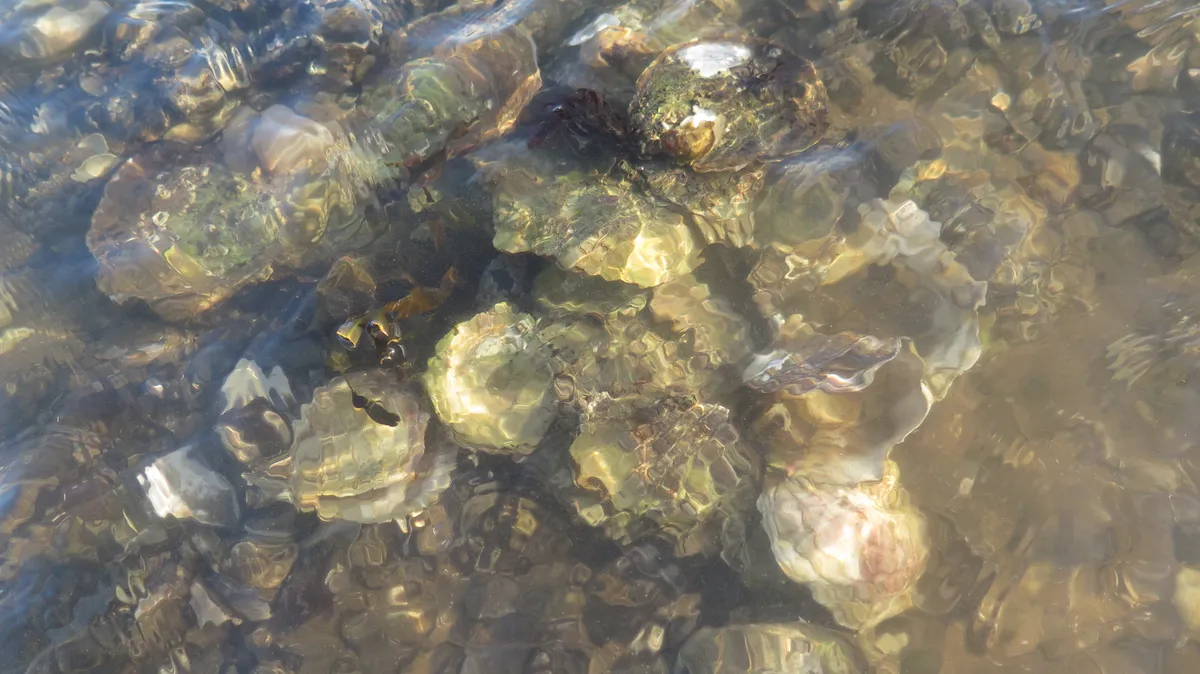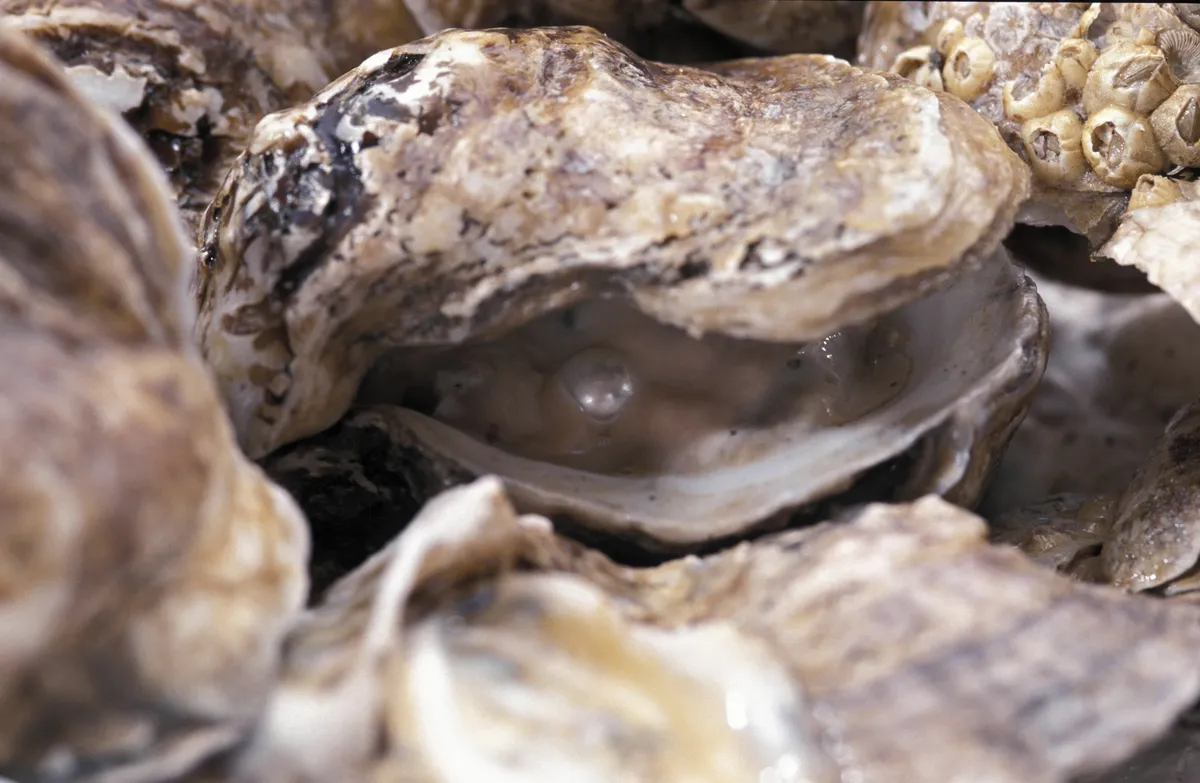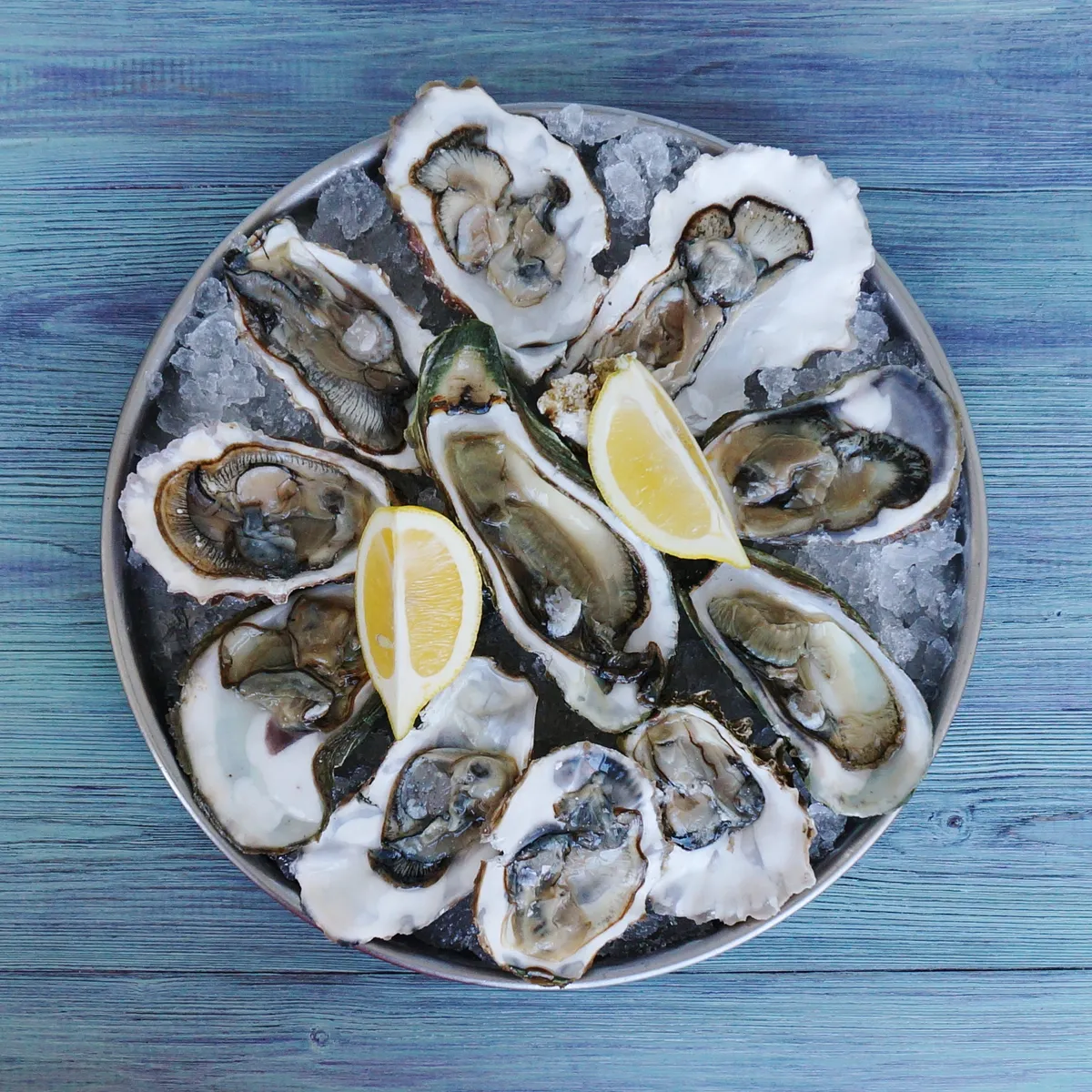Although it rarely forms pearls, the European native oyster is an important species in British waters where it improves water quality and creates reef systems.
Due to their extensive effects on the local environment and other wildlife species, European native oysters can be described as ecosystem engineers. Other ecosystem engineers include hippos, and Eurasian beavers.
Learn more this bivalve in our expert guide by Celine Gamble from the Native Oyster Network and the Zoological Society of London (ZSL):
How many species of oyster are native to the UK?
In the UK, there is only one species of true oyster that is native to our seas – the European native oyster (Ostrea edulis), also known as the European flat oyster. There are number of regional names for the species in the UK, including mud oyster, Colchester native oyster, and edible oyster.
The native oyster is a bivalve mollusc that has a rounded, rough shell with a pale green, yellow or brown colouring. Native oyster populations have declined by 95% in the UK since the mid-19th century. But, in recent years, there has been increased momentum to restore native oyster populations around our coastline.
What do oysters eat?
Oysters have an amazing ability to clean seawater, which in turn improves our water quality and clarity. A single oyster can filter around 200 litres of seawater daily. They use valves to pump water across hair-like gill structures, consuming suspended phytoplankton and organic matter.
Oysters are also able to remove excess nutrients from water, in particular nitrogen, which in high levels can promote harmful algal blooms, oxygen depletion, and fish mortality.

How do European native oysters reproduce?
Native oysters begin life as male, then – upon reaching sexual maturity at around two to three years of age – they spawn, following which they switch to females, capable of producing eggs.
This life history trait defines them as ‘protandrous alternating hermaphrodites’, capable of switching between male and female many times throughout their lifetime.
A female oyster of around 8cm in size is capable of producing 1 million larvae, while larger individuals are capable of producing as many as 2 million larvae in a single spawning event.
How do oysters form reefs?
Biogenic reefs are eventually created when large numbers of living oysters and dead shells form a complex, three-dimensional structure.
Similar to the role of coral reefs, oyster reefs provide a suitable habitat for a diversity of organisms, including sponges, spiny seahorse and Critically Endangered European eels.
They also provide protected nursery grounds for important juvenile fish species that support our fisheries, such as seabass.
Oyster reefs are usually formed on mixed substrate, such as mud, sand, gravel and shell, in shallow waters less than 10m deep. However, they have been found at depths of up to 80m.

Where are European native oysters found?
The European native oyster can be found in shallow, subtidal coastal and estuarine habitat. Oysters are highly gregarious, meaning that the oyster larvae prefer to settle where other larvae have settled, and they will also choose to settle on either live oysters or old shells from dead oysters.
In Europe, we now have less than 5% of native oyster populations when compared to historic levels. In the UK, populations are now predominantly found in the West Coast of Scotland or the South East of England, in areas such as the mouth of the Thames Estuary, the Solent, and the River Fal.

How do oysters make pearls?
European native oysters are classified within the ‘true oyster’ family, whereas pearl oysters are part of the ‘feathered oyster’ family, which are not actually closely related to true oysters.
Pearls are naturally made by oyster species within the feathered oyster family as a defence response to an irritant, such as a grain of sand, entering the oyster's shell or body.
To protect themselves from irritation, the oyster then layers the grain with multiple layers of ‘nacre’ — the substance that covers the inside of their shell, also known as mother-of-pearl.
European native oysters are not able to produce commercially viable pearls, and the chances of finding a pearl inside one of them is incredibly slim. When pearls are produced on a commercial scale, a species of oyster from the feathered family is used, such as a pearl oyster, and a grain is inserted into an oyster to trigger the production of a pearl.

How long have humans been eating oysters?
Oysters have long been a staple source of protein for humans, and there is evidence as far back as 8700 BC of Stone Age hunter gatherers harvesting oysters.
We also know that Romans ate European native oysters and records show that they were eaten in their thousands during feasts. In the Middle Ages, valuable oyster beds were recorded in the Domesday book in 1086.
Fast forward to the early 17th century, oyster trade was thriving, and by the 19th century more than 200 million European native oysters are thought to have been sold annually on the London market at a time when the city's population was below 2 million.
Parliamentary papers from the 19th century stated that the European native oyster fishery was as important as the herring fishery, which in the 19th century was thought to be ‘the greatest in the world’.

Why are European native oysters so important?
European native oysters may be only small (5–11 cm), but they are capable of making some big changes in the marine environment.
Oyster reefs support a higher biodiversity of species than the surrounding seabed and, as they filter feed, they vastly improve the quality of surrounding water.
Oysters also have the ability to remove excess nutrients from water, such as nitrogen, which in large quantities can be devastating to the environment as they cause harmful algal blooms, depleting oxygen and ultimately leading to fish death.
When oysters are present in large enough quantities and form dense aggregations or reefs, they are able to reduce coastal erosion, protect neighbouring habitat such as saltmarsh and seagrass, and can act as carbon sinks. For these reasons, oysters are known as ‘ecosystems engineers’.
Zoological Society of London
Founded in 1826, ZSL is an international conservation, scientific and educational charity. Through our dedicated conservationists and thought leading scientists we work to inspire, inform and empower people to stop wild animals going extinct.
About the Native Oyster Network
The Native Oyster Network is a growing community of academics, conservationists, oystermen and NGO’s who are working to restore self-sustaining populations of native oysters. The network was established by Dr Joanne Preston from the University of Portsmouth and Alison Debney, Senior Conservation Programme Manager at Zoological Society of London (ZSL) in 2017 to support the growing need of the species, habitat and those working to restore O. edulis in Europe.
About Essex Native Oyster Restoration Initiative (ENORI)
Essex Native Oyster Restoration Initiative was formed in 2013 with the aim of supporting the restoration of the native oyster in the Essex Estuaries and is chaired by international conservation charity ZSL (Zoological Society of London). The ENORI coalition aims to develop best practice in marine conservation and fisheries management, develop recovery projects and measures with the end purpose of healthy native oysters and oyster beds.
Main photo © David Smyth
